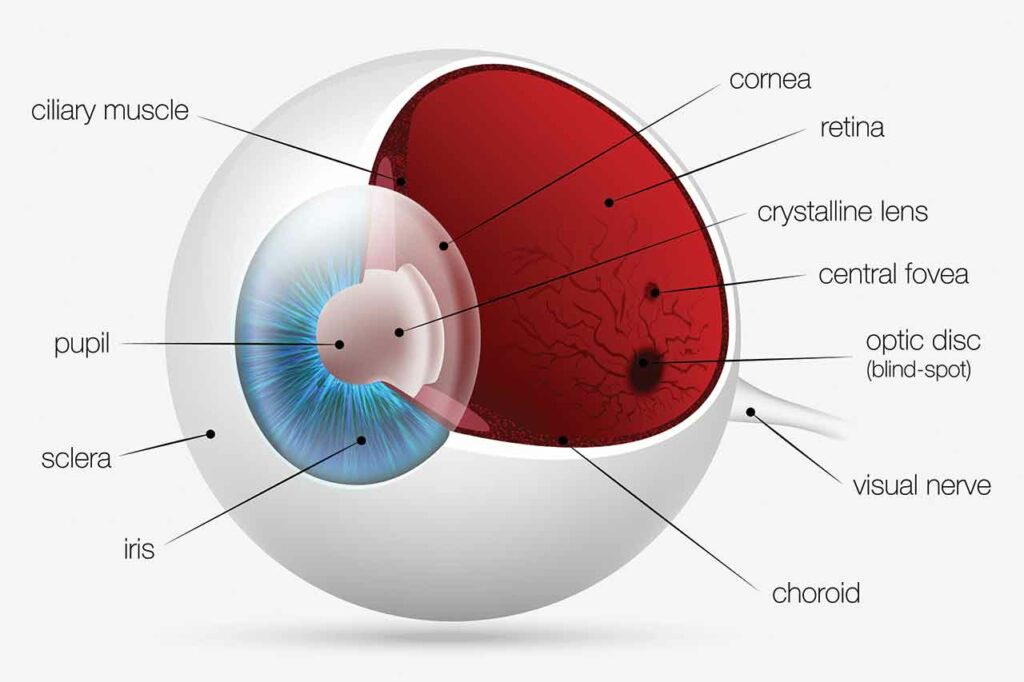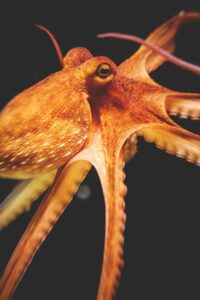How could evolution craft something as complex as the eye in the first place?
And how could it do it again and again and again?
*****
Everybody knows that our eyes are wonderfully designed, even those who don’t acknowledge their Designer. All the parts are special and each is important for vision.
So many parts
The bulging cornea consists of clear material that not only lets light penetrate, but bends it toward the pupil.
The iris consists of a thin circular muscle which acts like a camera diaphragm, controlling the size of the pupil opening. The iris expands or contracts the pupil opening in order to control the amount of light entering the eye.
 Behind the pupil is the lens which focuses light onto the retina (composed of light sensitive cells and nerve cells). The lens is a particularly important component of the eye. This oval shaped object is made up of water soluble proteins, many of which are very large molecules. These proteins are tightly packed together in such a way that they are not only transparent, but they bend the light so that the rays are focused into a sharp point. This provides a clear image. Ideally the lens focuses on the retina (the receiver), but if the focal point is in front of the retina (or behind it) then corrective lenses are required to adjust the focus onto the retina (ie. you’ll need glasses!). It is also most important that the proteins in the lens retain their special tightly packed arrangement, otherwise the lens becomes opaque thereby disturbing vision.
Behind the pupil is the lens which focuses light onto the retina (composed of light sensitive cells and nerve cells). The lens is a particularly important component of the eye. This oval shaped object is made up of water soluble proteins, many of which are very large molecules. These proteins are tightly packed together in such a way that they are not only transparent, but they bend the light so that the rays are focused into a sharp point. This provides a clear image. Ideally the lens focuses on the retina (the receiver), but if the focal point is in front of the retina (or behind it) then corrective lenses are required to adjust the focus onto the retina (ie. you’ll need glasses!). It is also most important that the proteins in the lens retain their special tightly packed arrangement, otherwise the lens becomes opaque thereby disturbing vision.
The other particularly important component of the eye is the retina. It consists of certain receiver cells which contain light sensitive pigments called rhodopsins. These are composed of a form of vitamin A and a large protein molecule called opsin. Different precisely shaped opsins are sensitive to specific wavelengths of light. In humans there are opsin molecules sensitive to blue light, or to green light or to red light. Cones are cells which contain one or other of the specific color sensitive opsins. Other cells called rods are sensitive only to more or less light. These rods and cones point backward to the back lining of the eye, but the light is coming from the front direction.
Before the light gets to the rods and cones, it passes through the nerve cells which lie on top of the light sensitive cells, between them and the incoming light. Some people suggest that this is backward wiring – they say the nerve cells should have gone behind the rods and cones for a more efficient arrangement of parts. But what do they know? Others suggest that having the nerve cells in front, lying on top of the rods and cones, protects these sensitive tissues from getting too much light.
When light is sensed an electrical pulse is generated by the rods and cones and conducted by the nerve cells to the optic nerve and to the brain. The brain, for its part, puts the electrical signals together into images which are communicated to the person’s consciousness.
There are other important components of the camera eye too, like the dark choroid layer lining the inner eyeball, which prevents light rays from scattering inside the eye, and jelly-like material which allows the eye to keep its shape. When we consider the special properties of all these component parts, we have to conclude that the camera eye is indeed a wonderful organ.
Other eyes
Among living creatures there are other eye designs as well. Some single-celled animals and even some much larger creatures make do with mere concentrations of light sensitive proteins or clusters of pigmented cells. In the many-celled animals, these are often associated with nerve cells. Some animals feature recessed eyespots to better focus the light. Creatures with jointed outside skeletons (exoskeletons) like insects, crustaceans, spiders, millipedes etc., are famous for their composite eyes. These bulbous structures are made up of many tiny eyes all of which focus on a central point. While these eyes are very good at detecting motion, they probably do not have the same sharp focus as the camera eye.
Before we become too proud of our fancy eye design however, let us reflect on a biological riddle. It sounds like the beginning of a joke, but it isn’t one and it’s not funny, not even mildly amusing. I can well imagine the groans from you the reader when asked, “What does a single-celled animal, a highly poisonous jellyfish, a bristly marine worm, an octopus and a fish or dog all have in common?”
The question seems so totally meaningless! What could a single-celled animal and a dog have in common beyond the obvious characteristics all animals share? The surprising answer is that all these creatures share a common design in the eye!
Now, most of us have likely heard that all creatures with backbones (vertebrates) enjoy “camera-style eyes.” But what about a jellyfish, octopus and a single-celled animal which closely resembles algae that cause toxic red tides in the sea? Do they have camera-style eyes too? Yes, yes and yes!
Octopus and squid
 Octopus and squid are perhaps the best-known animals without a backbone (invertebrates) that enjoy the benefits of a camera-style eye. We have all seen pictures of these creatures with their large eyes. Octopi are particularly intelligent, some say as intelligent as a housecat. Be that as it may, octopi make very good use of their eyes as they navigate their environment and catch food.
Octopus and squid are perhaps the best-known animals without a backbone (invertebrates) that enjoy the benefits of a camera-style eye. We have all seen pictures of these creatures with their large eyes. Octopi are particularly intelligent, some say as intelligent as a housecat. Be that as it may, octopi make very good use of their eyes as they navigate their environment and catch food.
The term cephalopod means brainy foot and it denotes a subgroup of mollusks which include squid and octopus. The cephalopod camera-type eye includes an iris, circular lens, gel filling the eyeball, pigment cells and photoreceptor cells that send an electrical signal to the optic nerve which is connected to the brain. In the case of the cephalopods, the light sensitive rods and cones are in front of the nerve cells (not behind as in vertebrates). Moreover the crystal proteins in the cephalopod lens act the same way as our lens does, but the proteins are not the same.
Since cephalopods have a body design (plan) that is radically different from that of vertebrates, and since the chemical components of the eye are different, not even mainstream scientists see any kind of evolutionary connection between us and the octopus.
Underwater worms
Most of us have handled earthworms in the garden or as fishing bait. These creatures have a complete digestive tract with a mouth at one end and an anus at the other end. They have strong muscles and a few projecting bristles, but no obvious sense organs although they react strongly to odors and the drying effects of light. This body plan possessed by a group called the annelids, does not seem promising for fancy sense organs.
However there are marine annelids called polychaetes (meaning many bristles) which lead more vigorous lifestyles. Among the polychaetes is an obscure group called alciopids. These are slender swimming creatures with conspicuous eyes. They actively pursue and catch prey. Most surprisingly, the eyes of these worms are camera-style eyes complete with cornea, lens and retina. And like cephalopods, the wiring of the retina features the light sensitive cells first with the transmitting nerve cells behind. Obviously there is nothing in the body plan of these annelids that is at all similar to vertebrates. So nobody imagines that there is a shared evolutionary history between the two groups. So where did the fancy plan for these eyes come from?
Box jellyfish
 As we move next to jellyfish consider this: these marine annelids don’t have much that could be called a brain, but they do at least have some small concentrations of nerve cells at the front end of their body. If there is going to be any interpretation of the images detected by the fancy eye, it would be in this “brain.”
As we move next to jellyfish consider this: these marine annelids don’t have much that could be called a brain, but they do at least have some small concentrations of nerve cells at the front end of their body. If there is going to be any interpretation of the images detected by the fancy eye, it would be in this “brain.”
Jellyfish however have no central nervous tissue (which could function as some sort of brain). These creatures therefore do not look like promising candidates for any benefit from camera-style eyes. Nevertheless box jellyfish do indeed possess camera-style eyes. The great differences with other creatures of similar eye design mean that no evolutionary relationship is imagined between eye-possessing box jellyfish, polychaete worms, octopi and vertebrates. It was in some other way that they came to possess the fancy eye blueprint.
Warnowiid dinoflagellates
If camera-style eyes in a jellyfish are unexpected, how weird would it be to see the same design in a single-celled animal? A July 1, 2015 Nature article communicated the astounding news that there are some single celled protozoans – Warnowiid dinoglagellates – that have a sensory structure “so complex that it was initially mistaken for a multicellular eye.” The component parts include a cornea, lens, iris and retina. It is these parts, which, declares Gregory Gavelis and colleagues “so resemble the camera-type eye of some animals that they have been speculated to be homologous [related through evolutionary descent].”
In a July 9, 2015 followup, also in Nature, Thomas Richards and Suely Gomes rhapsodized that: “evolution has stumbled on similar solutions to perceiving light time and time again.”
Different bodies, same eyes
In the course of this survey of creatures with camera-style eyes we have observed that obviously there was no line of descent linking them all – these creatures are too different to even contemplate such an idea, and everybody agrees on that.
Instead mainstream scientists contemplate the separate surprising appearance of the same blueprint/design for an eye in wildly different organisms by means of an unguided evolutionary process. In the cases that we have discussed, the lifestyles are not even remotely similar, so it would be surprising to see similar solutions, especially through chance processes.
Christians can conclude that, rather than any sort of common process, these common designs came about by the conscious choices of a Creator – the same Creator, rather than the same ancestor. God can bestow what features He likes on whatever creatures He so desires. There does not have to be a pattern or a reason why these creatures are the way that they are. When we see these examples as the work of God, our appreciation of the creation becomes much more profound.
A version of this article first appeared in the Sept 2015 issue. Dr. Margaret Helder also writes for the Creation Science Dialogue











